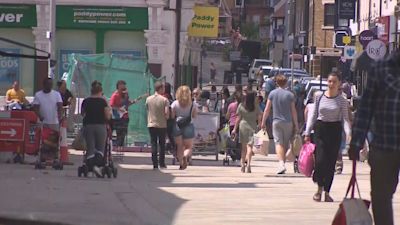Census 2021: Dartford sees 20% population boom as numbers grow across South East

Latest figures from the Census 2021 have revealed pockets of growing, ageing populations across the south east of England.
The region remains the most populous region in England with 9.3 million people, followed by London (8.8 million), while the North East was the least populous (2.6 million).
Overall the resident population of England and Wales was 59,597,300 on Census Day, 21 March 2021.
This was the largest population ever recorded through a census in England and Wales – an increase of more than 3.5 million (6.3%) compared with Census Day 2011.
Population growth
Dartford has seen a 20% increase in population, among the top three areas of growth across England and Wales.
Southampton increased in population by 5% since the 2011 census, and Portsmouth increased in population by 1%.
There has been some decline in population in some areas, including in both Gosport and the New Forest.
Ageing population
Overall the figures reveal an ageing population in the South East of England.
Rother has one of the highest populations of people aged 65 years and over at 32.4%.
Crawley has seen the biggest increase of women aged over 90. Whereas areas including Oxford, the Isle of Wight and Portsmouth have seen a reduction.
In Basingstoke, the New Forest and the Isle of Wight, almost a third of people are now aged over 65.
The Office for National Statistics’ deputy national statistician Pete Benton said: “Ultimately, the full suite of census results, based on the information we all gave, will ensure decisions about how the billions of pounds we spend each year as a nation are made using the best possible evidence.
"This includes planning our emergency services, mental health care, school places, hospital beds, houses, roads, buses, trains, trams, GPs and dentists’ services."
Data from the 2021 census for England and Wales will be published in stages over the next two years, the ONS said.
Future releases will include figures on ethnicity, religion, the labour market, education and housing plus – for the first time – information on UK armed forces veterans, sexual orientation and gender identity.
Other findings
There were 30,420,100 women (51.0% of the overall population) and 29,177,200 men (49.0%) in England and Wales.
Across England and Wales, the local authorities with the highest percentages of the population aged 65 years and over were North Norfolk (33.4%) and Rother (32.4%). East Devon had the highest percentage of the population aged 90 years and over (1.9%), followed by Rother (1.8%).
Compared with the other English regions, London had the largest percentage of people aged between 15 and 64 years (70.0%).
The local authorities with the highest percentage of persons aged under 15 years were Barking and Dagenham (24.5%), Slough (23.5%) and Luton (21.9%).
There were 24,782,800 households in England and Wales on Census Day; the number of households increased by more than 1.4 million since 2011 (6.1%), when there were 23,366,044 households.
There were 395 residents per square kilometre in England and Wales in 2021. This is about the same as 2.8 residents per football pitch-sized area of land. It compares with 371 residents per square kilometre in 2011 and 251 residents per square kilometre a century ago in 1921.
See how the population has changed where you live by clicking here.